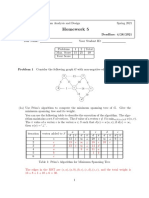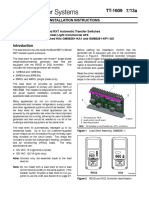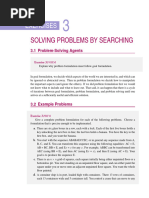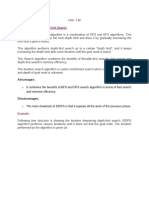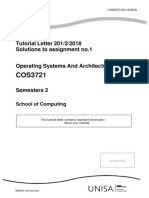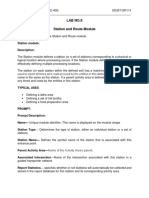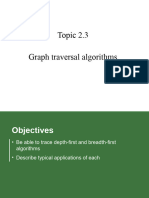CSE422 Assignment 1 Uninformed and Local Search
Uploaded by
Tafsin AnkanCSE422 Assignment 1 Uninformed and Local Search
Uploaded by
Tafsin AnkanDepartment of Computer Science and Engineering
Course Title: Artificial Intelligence
Course Number: CSE 422
Fall 2020
Student Honor Code
I will not cheat, use unfair means, join intentionally or unintentionally any un-
official online or offline group in which exam answers are posted or discussed,
or engage in any behavior that would commonly be deemed to be academically
unethical. I will immediately notify the course teacher of any such activity or
online or offline groups that I become aware of. I acknowledge that I may be
suspended or expelled from Brac University if I am found to have engaged in
any academically unethical behavior.
F igure1 : The track pieces in a wooden railway set; each is labeled with
the number of copies in the set. Note that curved pieces and “fork” pieces
(“switches” or “points”) can be flipped over so they can curve in either direc-
tion. Each curve subtends 45 degrees.
1. A basic wooden railway set contains the pieces shown in Figure 1. The task is to connect
these pieces into a railway that has no overlapping tracks and no loose ends where a train
could run off onto the floor
(a) Suppose that the pieces fit together exactly with no slack. Give a precise formulation
of the task as a search problem.
(b) Identify a suitable uninformed search algorithm for this task and explain your choice.
(c) Explain why removing any one of the “fork” pieces makes the problem unsolvable.
(d) Give an upper bound on the total size of the state space defined by your formulation.
(Hint: think about the maximum branching factor for the construction process and
the maximum depth, ignoring the problem of overlapping pieces and loose ends.
Begin by pretending that every piece is unique.)
CSE422 : Artificial Intelligence
2. The traveling salesperson problem (TSP) can be solved with the minimum-spanning tree
(MST) heuristic, which estimates the cost of completing a tour, given that a partial tour
has already been constructed. The MST cost of a set of cities is the smallest sum of the
link costs of any tree that connects all the cities.
(a) Show how this heuristic can be derived from a relaxed version of the TSP.
(b) Show that the MST heuristic dominates straight-line distance.
(c) Write a problem generator for instances of the TSP where cities are represented by
random points in the unit square.
(d) Find an efficient algorithm in the literature for constructing the MST, and use it
with A graph search to solve instances of the TSP.
3. Give the name of the algorithm that results from each of the following special cases:
(a) Local beam search with k = 1.
(b) Local beam search with one initial state and no limit on the number of states
retained.
(c) Simulated annealing with T = 0 at all times (and omitting the termination test).
(d) Simulated annealing with T = at all times.
(e) Genetic algorithm with population size N = 1..
4. Question 1 considers the problem of building railway tracks under the assumption that
pieces fit exactly with no slack. Now consider the real problem, in which pieces don’t fit
exactly but allow for up to 10 degrees of rotation to either side of the “proper” alignment.
Explain how to formulate the problem so it could be solved by simulated annealing.
5. In this exercise, we explore the use of local search methods to solve TSPs of the type
defined in Question 2.
(a) Implement and test a hill-climbing method to solve TSPs. Compare the results with
optimal solutions obtained from the A algorithm with the MST heuristic (Question
2).
(b) Repeat part (a) using a genetic algorithm instead of hill climbing. You may want
to consult Larra˜naga et al. (1999) for some suggestions for representations.
6. Generate a large number of 8-puzzle and 8-queens instances and solve them (where
possible) by hill climbing (steepest-ascent and first-choice variants), hill climbing with
random restart, and simulated annealing. Measure the search cost and percentage of
solved problems and graph these against the optimal solution cost. Comment on your
results.
CSE422 : Artificial Intelligence
You might also like
- Sample For Solution Manual Energy Systems Engineering 4th Edition by Vanek and Albright100% (1)Sample For Solution Manual Energy Systems Engineering 4th Edition by Vanek and Albright12 pages
- SAT Solver For Multi-Agent Sokoban PuzzleNo ratings yetSAT Solver For Multi-Agent Sokoban Puzzle17 pages
- Final Exam: CS 188 Spring 2019 Introduction To Artificial IntelligenceNo ratings yetFinal Exam: CS 188 Spring 2019 Introduction To Artificial Intelligence23 pages
- Artificial Intelligence: Uninformed SearchNo ratings yetArtificial Intelligence: Uninformed Search43 pages
- Playing Geometry Dash With Convolutional Neural NetworksNo ratings yetPlaying Geometry Dash With Convolutional Neural Networks7 pages
- Data Structures and Algorithms: (CS210/ESO207/ESO211)No ratings yetData Structures and Algorithms: (CS210/ESO207/ESO211)31 pages
- Tutorial Letter 201/2/2018 Solutions To Assignment No.1: School of ComputingNo ratings yetTutorial Letter 201/2/2018 Solutions To Assignment No.1: School of Computing8 pages
- Differential Evolution in Search of Solutions by Vitaliy Feoktistov PDFNo ratings yetDifferential Evolution in Search of Solutions by Vitaliy Feoktistov PDF200 pages
- U18PCCS501 Artificial Intellingence Uninformed SearchNo ratings yetU18PCCS501 Artificial Intellingence Uninformed Search21 pages
- KTU - CST202 - Computer Organization and ArchitectureNo ratings yetKTU - CST202 - Computer Organization and Architecture22 pages
- SearchInformed, Best First and A Star AlgosNo ratings yetSearchInformed, Best First and A Star Algos70 pages
- Informed (Heuristic) Search Strategies: Dept. of Computer Science Faculty of Science and TechnologyNo ratings yetInformed (Heuristic) Search Strategies: Dept. of Computer Science Faculty of Science and Technology19 pages
- Solution Manual For Dynamics by Boresi & Schmidt100% (2)Solution Manual For Dynamics by Boresi & Schmidt12 pages
- Railway Route Optimization System Using Dijkstra MethodNo ratings yetRailway Route Optimization System Using Dijkstra Method6 pages
- Algorithms T5 Graph Traversal AlgorithmsNo ratings yetAlgorithms T5 Graph Traversal Algorithms47 pages
- Education and Training: 12/08/2015 - 10/06/2019 - Meada Agame, Adigrat, EthiopiaNo ratings yetEducation and Training: 12/08/2015 - 10/06/2019 - Meada Agame, Adigrat, Ethiopia3 pages
- Cisco VCEup - 300-410 24-June-2022 158qNo ratings yetCisco VCEup - 300-410 24-June-2022 158q112 pages
- DATASTAGE Unable To Stop Job in DataStage Director - by Aysenur Karatay - MediumNo ratings yetDATASTAGE Unable To Stop Job in DataStage Director - by Aysenur Karatay - Medium8 pages
- Report Writing Presentation Evaluation Guidelines For BSC CSIT ProjectNo ratings yetReport Writing Presentation Evaluation Guidelines For BSC CSIT Project39 pages
- A Rational Function Is One That Can Be Written As A Polynomial100% (1)A Rational Function Is One That Can Be Written As A Polynomial20 pages
- 158955https://sites Google Com/view/money-Robot1No ratings yet158955https://sites Google Com/view/money-Robot12 pages
- Cambridge International AS & A Level: Computer Science 9618/32No ratings yetCambridge International AS & A Level: Computer Science 9618/3212 pages
- Ex. No. 03 Construct An Application That Draws Basic Graphical Primitives On The Screen DateNo ratings yetEx. No. 03 Construct An Application That Draws Basic Graphical Primitives On The Screen Date4 pages
- 19 May Congress of Innovative Scientific Approaches: 10Th InternationalNo ratings yet19 May Congress of Innovative Scientific Approaches: 10Th International418 pages


